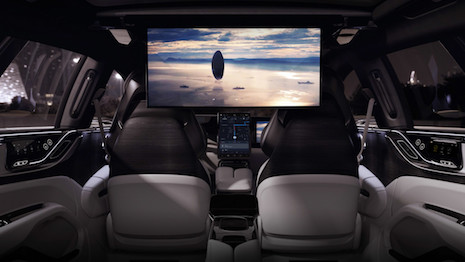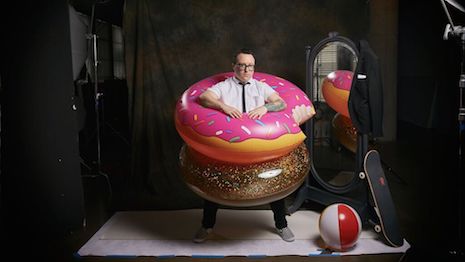 The Faraday Future FF91's system uses facial recognition, voice recognition and the person’s weight to tailor individual seat settings, including setting the right temperature and sound volume level.
The Faraday Future FF91's system uses facial recognition, voice recognition and the person’s weight to tailor individual seat settings, including setting the right temperature and sound volume level.
The major problem with many auto brands, especially luxury marques, is that it is simply not good enough just to use Android Auto or Apple CarPlay in their vehicles.
Many automakers use third-party tech because they have not invested in their own experience or their experience just is not good enough, according to Paul Woods, CEO and chief creative officer of Edenspiekermann, a Los Angeles-based design consultancy.
“I think it reveals a huge gap between the brands that have invested in their own proprietary user experience,” Mr. Woods said.
In this Q&A, Mr. Woods – author of “How To Do Great Work Without Being An Asshole” – shares trends in artificial intelligence, user experience in the crop of next-generation electric vehicles and how smart technology will be a game-changer for all auto brands. Please read on:
In what ways has the advent of artificial intelligence (AI) modernized the auto industry?
AI is a term that is thrown around quite loosely.
We all think of the old ‘80s show, Knight Rider, the car that you can talk to you. Yes, a voice assistant is a big part of the modern car’s user experience (UX), but it’s just one aspect.
The bigger picture is more about the relationship people have with their car and developing the technology that makes driving more personal so the car essentially gets to know you.
What does that look like in the real world? How does a car "get to know me"?
We worked on the user experience in Faraday Future FF91, which is a monster piece of technology.
The car’s AI uses sensors, cameras and software – more than three years in development – to create a custom user experience.
The system uses facial recognition, voice recognition and the person’s weight to tailor individual seat settings, including setting the right temperature and sound volume level.
Each seat is 14-way adjustable with 4-way lumbar support.
There’s also a “Spa Mode” that can change the lighting and audio.
You worked recently with Mercedes also. Can you talk about what you did for both them and Faraday Futures?
With Faraday, the AI was literally front and center.
The brand promise of the car centers around the killer tech and the “intelligence” of the experience.
We worked with them on defining how to translate their brand into a digital product experience through extensive personality workshops, prototyping and then bringing it all together with UX, UI and motion.
The Faraday brand is all about the tech.
Mercedes is a different brand built more around luxury than tech. It’s just as much a technical marvel as Faraday, but the tech is less of a marketing set-piece.
A lot of cars are outfitted with Apple’s CarPlay or Google’s Android Auto. What do you think of the AI and user experience they deliver?
When people are buying a car, especially a luxury car, you're buying a brand, you're buying a lifestyle, you're buying a Mercedes because you want that luxury lifestyle.
The big problem with a lot of auto brands, especially luxury brands, is that it's not good enough just to use Android Auto or Apple CarPlay.
Many brands use third-party tech because they haven't invested in their own experience or their experience just isn't good enough.
I think it reveals a huge gap between the brands that have invested in their own proprietary user experience.
If it's done well, a proprietary interface is going to be much better because it's built for that brand. It knows that the physical attributes of the car better, it knows it can interact with the physical properties of the car better so you get a fuller picture of what's actually going on with the car and thus integrate technology with the physical car much more seamlessly.
You can't do that with Apple CarPlay because it just sits on top of your car’s tech.
But I get it: it's hard to build a proprietary experience. It's a long-term investment.
 Paul Woods is CEO and chief creative officer of Edenspiekermann, Los Angeles
Paul Woods is CEO and chief creative officer of Edenspiekermann, Los Angeles
General Motors recently announced it was expediting plans to invest in electric vehicles, spending $27 billion by 2025 in an effort to be a global leader in electric vehicles. How should it be thinking about UX?
My advice is to invest in the user experience best for your brand, and the technology needs to express that.
Think about the car’s ability to be preconditioned – turned on, warmed up, music is chosen and route planned – and creating tech that identifies patterns based the way most GPS apps can.
Also, the UX can help address the stressors that come with using an electric car, including range anxiety, where drivers worry about battery life and where they can easily recharge, as well as issues related to whisper-quiet driving, one-speed transmissions and regenerative braking functions that can all be strange for drivers new to EV.
Given how in the United States, especially, cars have a certain sense of individualism attached to them, at least for some people. For them, the idea of preconditioning does not really resonate. Is that a branding challenge that can be overcome? Do some drivers not just want their truck to be a five-speed manual drive?
I think you hit the nail on the head though, the individualism. It’s why we buy a car brand. It’s why I drive a Jeep. I like lifestyle and the brand reflects that. It’s why most people choose a specific car brand.
Of course, budget is a consideration, but even within their budget, people will always choose something that reflects their personality, their aspirations, etc. But the technology needs to reflect that too.
You may not want to drive Faraday or a Tesla, but you still want the cool features. You still want a smart vehicle with good tech, just maybe not so front and center in the UX.
Smart tech will always be a game-changer for any auto brand.
People judge technology against the experience on their phones.
The goal with any in-car experience is to make an experience [that] users love as much as their iPhone.
Has the pandemic caused brands to think differently about how customers interact with technology?
Absolutely. Today’s brand touch points are almost exclusively digital, making it crucial that that experience reflects the promise of the brand. It is no longer optional.
While technology has enabled the world to get through pandemic thanks to remote working, communication, online shopping, food delivery, etc., it’s also made us more exhausted and anxious than ever.
With the boundaries between home and work life blurred, we never switch off. We doom-scroll. We have literally zero privacy.
User experience is not going anywhere, but I predict in the coming years there will be a throwback to simpler times when technology is less intrusive – still there, of course, but less all-consuming and more utilitarian.
